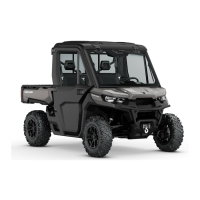MOVING LOADS AND DOING WORK
Operating While Carrying a Loads
Reduce your speed when carrying
cargo and turn gradually. Avoid hills
and rough terrain. Allow more distance
for braking. This vehicle may require
additional stopping distance if carrying
heavy loads, especially on inclined sur-
faces.
TiltingtheCargoBox
The cargo box can be tilted to ease un-
loading. Use release handles on either
side of cargo box.
tmo2016-010-001_a
VIEWED FROM RH SIDE OF VEHICLE
1. Release handles
NOTICE
Always turn off engine
when tilting the cargo box.
WARNING
– Always ensure no one is stand-
ing behind the cargo box before
you actuate the release handle.
– The load weight may affect the
operation of the cargo box tilt-
ing feature (tilting or lowering).
Be very careful with the operation of
thetailgateandthecargoboxasthe
load may have moved during trans-
port.
To lower the cargo box, simply push it
down into place.
WARNING
– Keep yourself and others clear
of the cargo box and vehicle
frame junction when lowering
cargo box.
– Ensure to properly latch the
cargo box and the tailgate be-
fore riding.
– Make sure you do not leave ob-
jects between lifted cargo box
and vehicle frame to ensure
proper latching of the cargo box
when lowered.
tmo2016-010-002_a
FRONT SECTION OF INCLIN ED CARGO BOX
FREE OF ANY OBJECTS
Hauling a Load
NOTICE
A BRP approved rear
hitch must be properly installed on
the vehicle for hauling trailers.
Never pull a load by attaching it to the
cage; this can cause the vehicle to tip
over. Use only the trailer hitch or winch
(if installed) to pull a load.
When pulling loa ds with a chain or ca-
ble, ensure that there is no slack before
starting and maintain tension while
pulling.
When pulling loa ds with a chain or ca-
ble, be sure to brake progressively.
The inertia of the load could lead to an
impact.
________
SAFETY INF
ORMATION
________
29

